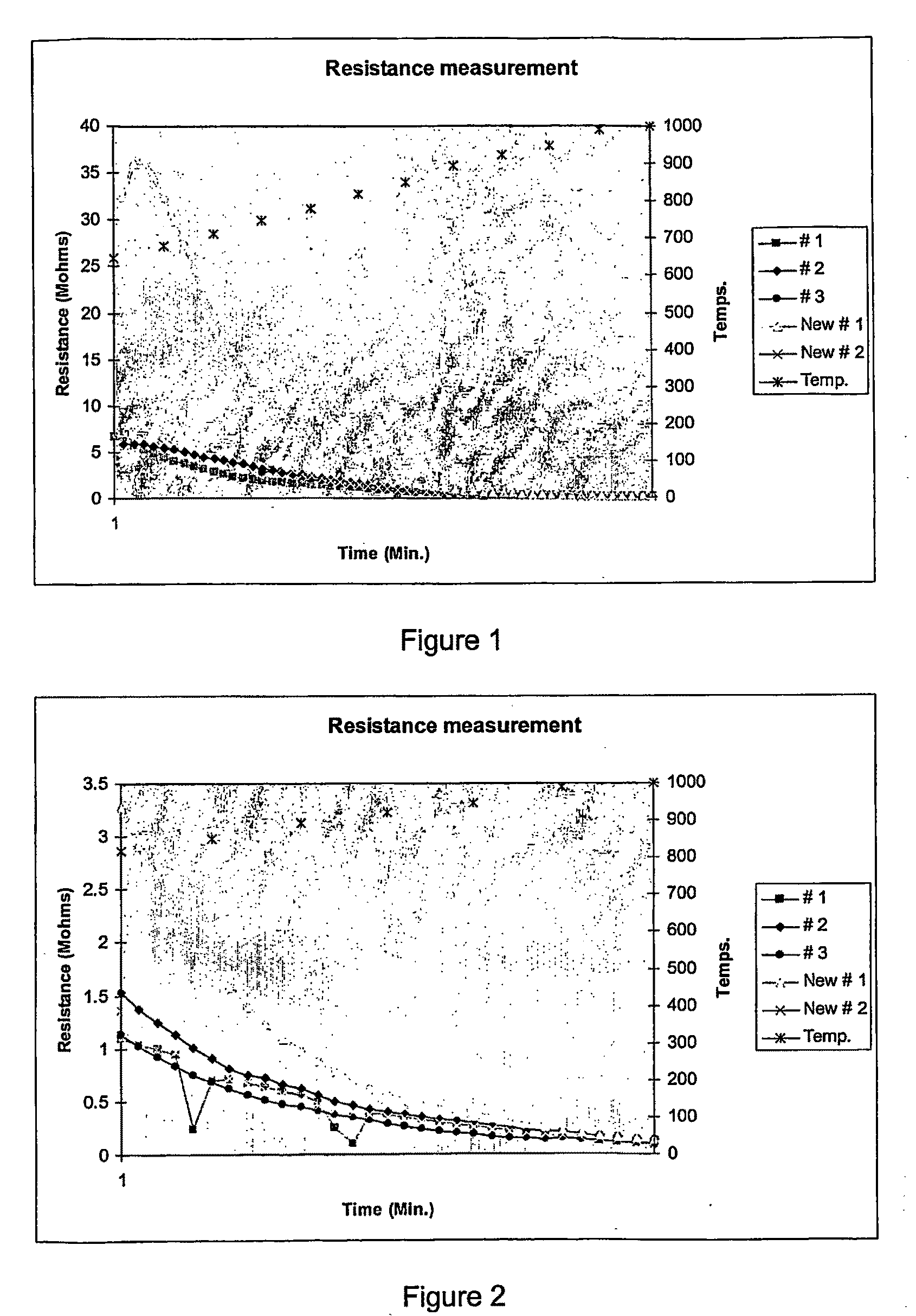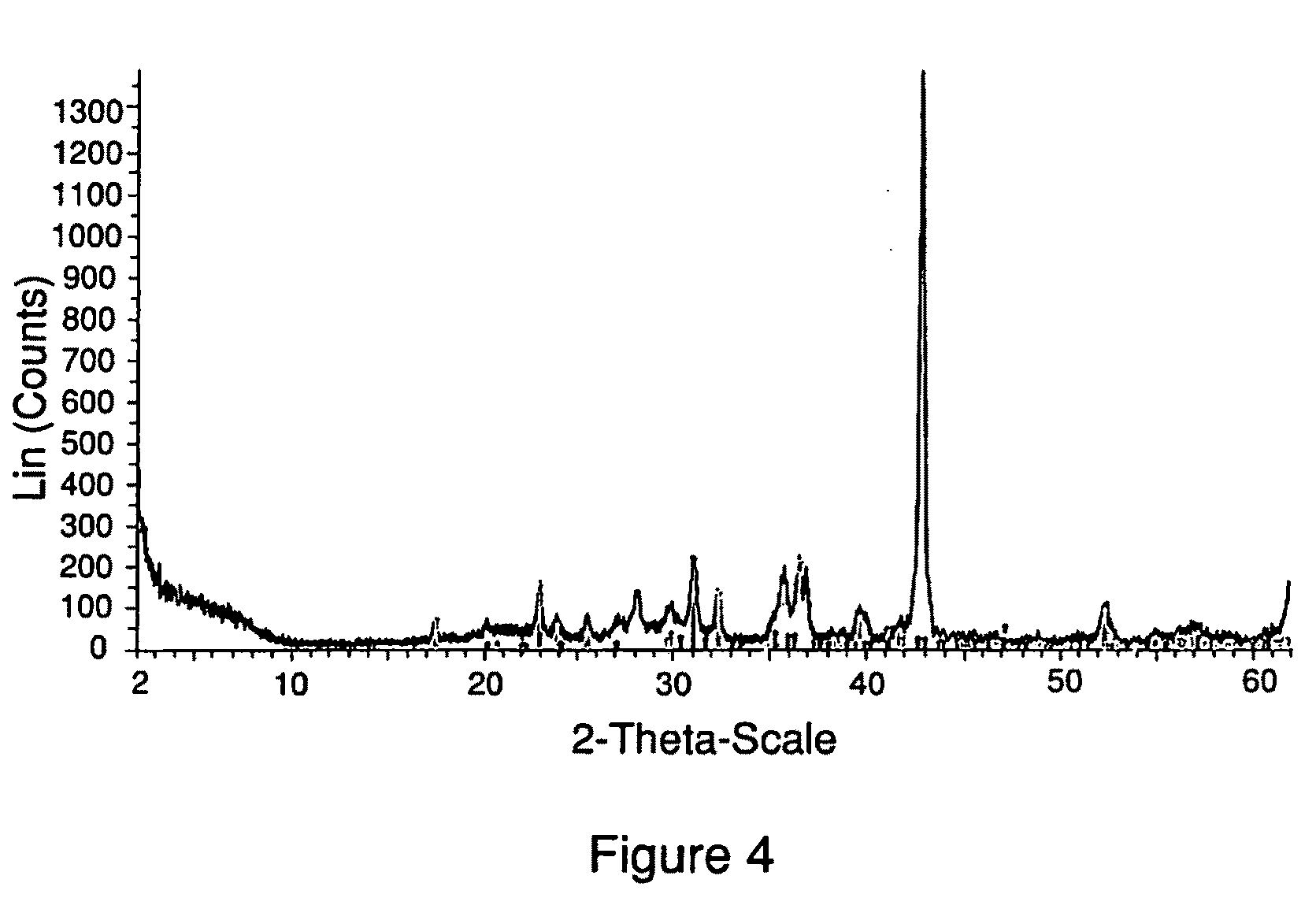Fire Resistant Compositions
a composition and composition technology, applied in the field of polymeric compositions, can solve the problems of inhomogeneous insulation materials, circuit integrity, slow tape around the conductor, etc., and achieve the effects of reducing weight loss, good processing and mechanical properties, and less likely to shrink and crack
- Summary
- Abstract
- Description
- Claims
- Application Information
AI Technical Summary
Benefits of technology
Problems solved by technology
Method used
Image
Examples
example 1
[0121]Three conventional polymeric compositions and three polymeric compositions (Table 1) of the present invention were measured for resistance (Mohms) between 700-1000° C. and 800-1000° C. As illustrated in FIGS. 1 and 2, the polymeric composition of the present invention (samples new2 (190106-1), new3 (190106-2)) exhibited higher resistivity than conventional compositions (samples 1, 2, 3). XRD analysis of polymeric composition new3, before and after exposure to 1000° C. revealed the conversion of magnesium hydroxide to forsterite, as illustrated in FIGS. 3 and 4.
[0122]After being heated to 1000° C. for 10 minutes the ceramic products samples new1, new2, new3 were found to be hard, although new1 was, in comparison to new2 and new3, softer. The compositions also exhibited good to excellent resistance to water and shape retention.
TABLE 1Polymeric composition123New 1New 2New 3Nordel IP476011.411.411.4———Engage ENR7256———353535Keltan2340A6.96.96.9———Evatane 33-454.74.74.7555Chinese A...
example 2
[0123]This example examines the ability of magnesium hydroxide and silica to replace existing inorganic minerals, specifically talc and clay (translink 37), to form a polymeric composition that would have good fire and water resistance properties at high temperatures. All compositions produced polymeric compositions with good tensile and % elongation properties (Table 3).
[0124]When heated to 1000° C. for 10 minutes, the ceramic products were hard and had visually good shape retention. Samples 2-1 to 2-4 are shown in FIGS. 5 and 6. Samples 2-3 showed good water resistance which may be related to the higher densification of this sample, due to the elevated alumina levels from the clay and ATH.
[0125]The % shrinkage was measured by holding samples of approximately (38 mm (L)×13 mm (W)×2 mm (D) rectangular sections, uncovered on a block of isolite and exposing the samples to 1000° C. for 10 minutes. The % shrinkage was determined by calculating the % decrease in the length of the sample....
example 3
[0127]A conductor made of bunched 7 wires of plain copper, 0.5 mm diameter (1.5 mm2) was insulated to a wall thickness of 1.0 mm with both a Ceramifiable composition as disclosed in earlier Australian patent application no 2004225453 and a composition of the present invention. The lengths of insulated conductor were then cut to suitable lengths and then assembled (laying up process) into four core cables. The assemblies were taped with foamed polypropylene tape, then sheathed with a commercially available halogen-free flame retardant sheathing composition. Such sheathing materials are readily available and are well known in the cable industry. The two cables were then attached to galvanised steel cable trays, with two changes of direction in the fire zone and bending radius of 10 times cable overall diameter and the trays were then placed atop a furnace with dimensions of 1200×1200×1200 mm. This furnace is capable of providing the standard temperature-time curve used in the building...
PUM
| Property | Measurement | Unit |
|---|---|---|
| wt % | aaaaa | aaaaa |
| wt % | aaaaa | aaaaa |
| weight % | aaaaa | aaaaa |
Abstract
Description
Claims
Application Information
 Login to View More
Login to View More - R&D
- Intellectual Property
- Life Sciences
- Materials
- Tech Scout
- Unparalleled Data Quality
- Higher Quality Content
- 60% Fewer Hallucinations
Browse by: Latest US Patents, China's latest patents, Technical Efficacy Thesaurus, Application Domain, Technology Topic, Popular Technical Reports.
© 2025 PatSnap. All rights reserved.Legal|Privacy policy|Modern Slavery Act Transparency Statement|Sitemap|About US| Contact US: help@patsnap.com



